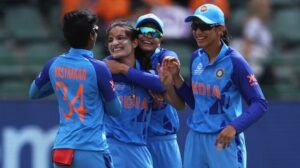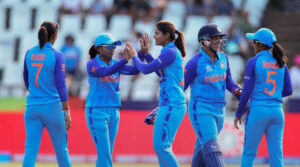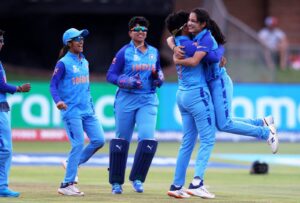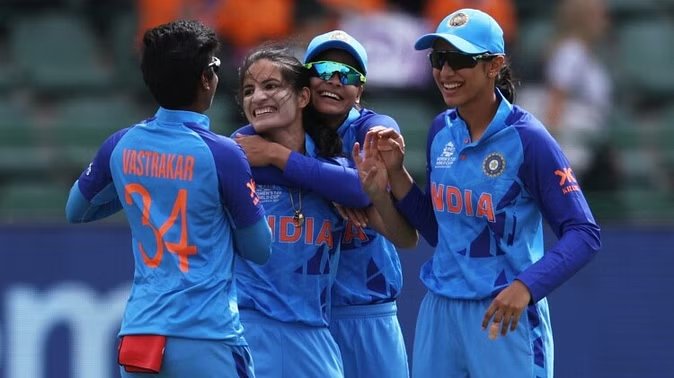
–Boria Majumdar
With the huge Australia semi final later today, it is time to get behind the blue brigade. Not the Indian women’s cricket team. Rather, the Indian team. Kaur, the captain, leading an Indian team out in South Africa will yet again galvanize the nation and corporate India will be forced to take notice. The women, lest we forget, are equal stakeholders in the decision-making as the men.
There is indeed enough momentum for a revolution
When we left Mumbai to play in the world cup there were hardly any journalists who had come to the airport to see us off. But when we returned to India on 25 July having made the final there were close to a hundred journalists at 2.30am in the morning. I was surprised to see so many journalists and must tell you the flashes just did not stop. This was something totally new. Since then all of us have been flooded with interview requests and offers. We have been invited to events, have been felicitated and celebrated the country over. Today people stop to greet us and recognize us. I have been playing for India for 18 years now and this has never happened before. So in that sense 2017 has made a huge difference to our sport.
Mithali Raj- Captain of the Indian Team in 2017.
Sample this. Barely a dozen journalists were present at the press conference, where India captain Mithali Raj outlined her plans for what was the to be the biggest tournament of her career, before leaving for England in June 2017. On 26 July, more than sixty journalists and cameramen flocked to the Grand Ballroom of the JW Marriot in Mumbai, where Raj and her girls fronted the felicitation presser, less than three days after coming second-best to England in a closely contested World Cup final.
Yes, you read that right: in the dead of night, the Mumbai airport was teeming with fans, junior cricketers, policemen and the media, who couldn’t seem to get enough of the Indian team.
‘“Obviously, it’s quite overwhelming to see such kind of a reception. It’s first of its kind for all of us,” Raj had said. “I did face something similar [in terms of our outcome in the final], not exactly similar, but a little lesser in 2005. But then there was no BCCI. At that time, I was wondering had we been under BCCI, what kind of reaction we would have or what kind of feedback we would have got back home. But today I can actually feel it’s such a huge thing. It’s just the beginning of good times for women’s cricket.”’
Even when Jhulan Goswami landed in Kolkata the next day, there were no fewer than fifty journalists present at the NSCBI airport. The team was awarded INR 50 lakh each by the BCCI and other hefty monetary rewards and commendations were subsequently conferred on them by the state associations and the Indian Railways.

The build-up to the final on 23 July 2017 had started early in the morning. Queues of Indian fans began making their way into the stadium well in advance of the start of play—a sight so very common whenever India plays at Lord’s. Only this time it wasn’t Rohit Sharma, Virat Kohli and the boys. It was Raj, Goswami, Harmanpreet Kaur and eleven other women, who had finally forced the Indian cricket fan in London and beyond to come to Lord’s waving the tricolour and hollering for the blue brigade. Back home, the build-up was no less momentous. All India Radio, in a rare gesture, had organized live commentary in multiple languages and the host broadcaster was showing the match across eight different channels. Not to be left behind the news channels, which play a key role in generating buzz, all of them had multiple shows right through the day. Suffice to say, it was the biggest news event in the country on the day.
Furthermore, even when the team lost, the buzz did not diminish. From the prime minister of India down to other high-profile politicians, sports-stars and Bollywood celebrities, social media was a rage, celebrating the achievement of Raj and her team. The sport, it was apparent, was no longer an also-ran. The team had done enough to lift it out of oblivion and shove it right at the centre of public discourse. Each of the players, stars in their own right, have been celebrated since.
There were no television cameras in 1983 when Kapil Dev smashed that 175 against Zimbabwe and rescued India from the depths of despair. While the world missed out on seeing the heroics, for his teammates the knock had the effect of making them feel that a miracle was indeed possible. A dream that few dared to even think or speak about, turned into a reality in the next two weeks. Prior to the 1983 World Cup triumph, India’s victories, few and far between, were hardly accorded the recognition they merited. With 1983, it all changed.
Harmanpreet Kaur’s unbeaten innings of 171 against Australia in the semi-final in 2017, which was broadcast live across the world, had equal potential and more. Kaur was trending ahead of the newly elected president of India, Shri Ramnath Kovind, and had broken through as the emblem of a blue billion that dared to believe. Every six that came out of Kaur’s bat was a statement in itself—pushing the need for more recognition and better pay, telling corporate honchos what this team is capable of, stating in unequivocal terms that the BCCI needs to do more for women’s cricket in the country and do so immediately. So what if the opposition had Meg Lanning and Ellyse Perry, Raj and her blue brigade were out there to seek immortality. The anger Kaur vent at nineteen-year-old Deepti Sharma for running slow towards the non-striker’s end was not so much because Kaur’s 100th run was at stake, but, as she later explained, was due to the significance she attached to Deepti’s wicket in the context of the game. Kaur, the vice-captain, was aware of the enormity of the occasion. Her outburst was as much a testimony to the currency she attributed to every run that was to be scored or conceded in the match by India as it was an outpouring of the collective angst of Indian sportswomen, who, for the longest time, have been discriminated against. The World Cup, for Kaur, Raj, Goswami and the other girls was an opportunity that they couldn’t afford to let go. Even though they fell nine runs short of lifting the trophy, they had done enough to ask the BCCI for equal treatment and demand what is their fair share.
Kaur’s innings of 171 had done far more than just take India to the final of the World Cup. It had given women’s game a new identity that it so badly needed. More importantly, others who nurtured a silent ambition to be the next Kaur or Raj, but stopped short of saying so for familial and other pressures, found a new voice.
On 23 July 2017, eleven Indian girls stepped onto the hallowed turf at the Lord’s cricket ground, knowing they were on the cusp of history. Rather, they were shaping history.
How best to explain to my readers how difficult it was for these girls? I have to go back to the 1994 football World Cup or to the penalty shootout involving Argentina and Lionel Messi a few years earlier. Roberto Baggio stepped up to thunderous applause to take a key penalty. He had won hearts that tournament and was the next big Italian superstar. Baggio, most felt, could never miss. He did. And so did Italy. Can Baggio ever come to terms with what had happened that instant as he took that shot? Does he replay it in his mind? It will be a huge surprise if he doesn’t.

And then there is Messi. The Argentine superstar has come close to achieving immortality numerous times in his career. He came close in 2014 against a raucous German side that had thumped Brazil 7–1 in the FIFA World Cup semi-final. Could he go past them and, once and for all, close out the comparison with Diego Maradona? Could he prove to the world that he is as good as the Argentinian legend. Unfortunately for Messi, he wasn’t able to then. The trauma was such that he had even contemplated retirement. While Raj and Goswami have gone away from the game knowing they were as close as one can possibly get, Kaur, Deepti, Smriti and Richa have another opportunity tonight just like Messi had in Doha in December 2022.
Messi found redemption and immortality. Will the girls tonight?
With the huge Australia semi final later today, it is time to get behind the blue brigade. Not the Indian women’s cricket team. Rather, the Indian team. Kaur, the captain, leading an Indian team out in South Africa will yet again galvanize the nation and corporate India will be forced to take notice. The women, lest we forget, are equal stakeholders in the decision-making as the men.
There is indeed enough momentum for a revolution.




